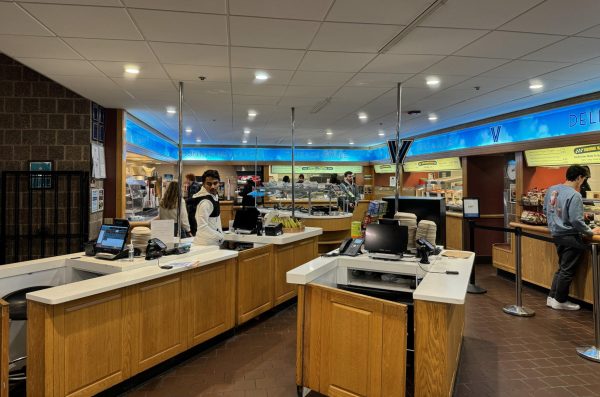Wildcat statue awaits approval
November 15, 2006
Approximately two years ago, the University’s Omicron Delta Kappa leadership fraternity brought forth the idea to create a Wildcat statue that would symbolize the University as a whole. ODK wanted to create something that would begin a tradition for the school, according to Dean of Students Paul Pugh, the chairperson of the Wildcat statue committee.
Since then, Pugh and the committee have created the Wildcat statue to symbolize the pride of Villanova. Pugh indicated that the Rev. Richard Cannuli, O.S.A., was consulted because of his art background and that the concept of creating the Wildcat statue was then forwarded to the Vice Presidents Council.
Pugh also consulted such departments as Mission Effectiveness to ensure that the Wildcat complied with the University’s mission statement.
Pugh could not project a definite cost for the figure because the committee is currently asking for estimates from the artist and the foundry.
Also, Pugh said the committee wants to make sure the statue is between 5 feet and 6 feet tall, with a bronze cast.
A bronze cast was preferred over stone or concrete because of preservation issues.
While stone figures need more maintenance, “Bronze is stronger, and you only have to really provide maintenance on it every three to five years,” Pugh said.
Though many universities have large statues to symbolize athletic menace, Pugh said the Wildcat statue is not for that purpose.
“It is not meant to be comedic, and it is not meant to be like a school’s mascot,” Pugh said. “It is also not meant to be like a fierce animal with its teeth sticking out at you. Our idea was to make it not like an attack-ready lion, but free-moving and in a proud walking stance that conveys a sense of alertness and pride.”
The Wildcat, according to Pugh, is supposed to characterize the University community and its pride as a whole, not a representation of one particular department, such as Athletics.
“So many people hear the word ‘wildcat’ and so many different images go through their heads, there ends up not being one definite image,” Pugh said. “We hope our Wildcat will make the image a tangible one and one that identifies us all. For some people, they’ll rub it for good luck right before a basketball game, for others, right before a huge test. It’ll have its own meaning for everyone.”
The Wildcat statue would rest at eye level in order to create a personal atmosphere for those who pass by it. Minimal landscaping would accompany the statue, and a spotlight would focus on it to create a subtle, yet classy image of the Wildcat.
Pugh hopes this ambiance will create a central experience for everyone who passes by. He hopes that people will want to stand by the Wildcat and take pictures with it and that by doing so, a tradition will be created. The committee has forwarded the proposal to University President Rev. Peter Donohue, O.S.A., for consideration.
Though the committee hopes that this step of the process will not take too long, Pugh recognizes the proposal must go through a process.
“Obviously, the project still has to go through proper channels before it’s approved,” Pugh said.
The location of the statue has yet to be determined. The committee has been considering several locations.
However, certain locations on campus already contain landmark statues, such as the grotto, the St. Augustine Center and the area behind the Augustinian monastery. The committee also does not want to place the statue in an area that is or will be affected by future construction.
The location of the statue will also require coordination with the Facilities Management Office. Several potential locations were scratched by Facilities because of the wiring and cables that lie underneath the ground in those locations.
The committee said that a possible location for the statue might be the grassy area between the side of Jake Nevin Fieldhouse and the front entrance of the Pavilion.
That location, according to Pugh, would be good because, “It’s in a very open location on campus where everyone on campus can see. It is easily accessible and there would be minimal interruption. It is also in a place that can be easily monitored by Public Safety across the street.”
Also, Pugh noted, while the Pavilion is central to athletics, it has now opened itself to bigger events that are not affiliated with the department. One major problem that the committee faced is the fact that a singular wildcat does not exist. Wildcats encompass such animals as bobcats, lynxes and caracals.
“In a way, though, the Wildcat is a perfect representation of us all because it’s all inclusive and nondiscriminatory,” Pugh said.
However, when sketches were drawn, it became more apparent that the facial expressions of the bobcat and the bobcat’s overall demeanor best suited the committee. Years back, Pugh said, the University even used to have a bobcat that served as a mascot on campus.
Though an artist has created a miniature clay sculpture of the Wildcat, it is in no way a finalized project.
“We’re definitely still in the planning phases, and we want to see what students think about it,” Pugh said. “So far, we’ve only gotten positive feedback, and people have said that they love it. But we’re all really excited about the project, and whatever it turns out to be, we just hope it will be something that creates a tradition here.”
Pugh also indicated that he plans to bring the small three-dimensional clay model of the Wildcat statue to one of the upcoming meetings of the Student Life committee of the University Senate in order to solicit feedback.
The clay model currently sits in the waiting area of his office on the second floor of Dougherty Hall.










